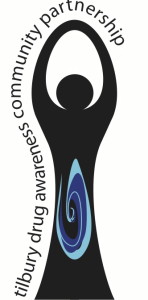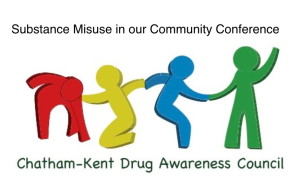Here is a list of some of the common drugs found in Canada. Click on a drug name to learn more.
Cocaine

Description
Cocaine is a fine white crystalline powder obtained from the leaves of the coca plant. It is commonly cut with other powders such as corn starch or sugar. Crack cocaine looks like white rock salt or white candle wax. It often has a yellow colouring.
Consumption
Cocaine can be sniffed, inhaled, eaten, or rubbed onto the mucous membranes of the nose. Cocaine is often sniffed up the nose through rolled-up dollar bills. “Rails” are lines of cocaine which is snorted. “Cap shots” refers to cocaine, which is placed in a cap and ‘dumped’ up the nostrils.
Crack cocaine can be smoked or melted, or injected. Common paraphernalia includes pipes, small pieces of glass or mirrors, razor blades, or hypodermic needles.
Effects
Using cocaine has a variety of adverse effects on the body. For example, cocaine constricts blood vessels, dilates pupils, and increases body temperature, heart rate, and blood pressure. It can also cause headaches and gastrointestinal complications such as abdominal pain and nausea. Because cocaine tends to decrease appetite, chronic users can become malnourished as well.
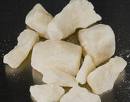
Different methods of taking cocaine can produce different adverse effects. Regular intranasal use (snorting) of cocaine can lead to loss of the sense of smell, nosebleeds, problems with swallowing, hoarseness, and a chronically runny nose. Ingesting cocaine can cause severe bowel gangrene as a result of reduced blood flow. Injecting cocaine can bring about severe allergic reactions and increased risk for contracting HIV and other blood-borne diseases. Binge-patterned cocaine use may lead to irritability, restlessness, and anxiety. Cocaine users can also experience severe paranoia—a temporary state of full-blown paranoid psychosis—in which they lose touch with reality and experience auditory hallucinations.
Regardless of the route or frequency of use, cocaine users can experience acute cardiovascular or cerebrovascular emergencies, such as a heart attack or stroke, which may cause sudden death. Cocaine-related deaths are often a result of cardiac arrest or seizure, followed by respiratory arrest.
Street Names
All-American, Angie, Aunt Nora, base, beam, Bernie, black rock, Blanca, blow, California cornflakes, candy, happy trails, icing, king, lady, nose candy, pearl, powder, sleigh ride, snow, snow cone, soda, white, zip.
Ecstasy (MDMA)
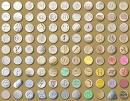
Description
The chemical name for ecstasy is methylenedioxy-methylamphetamine, or MDMA. The chemical structure and the effects of MDMA are similar to amphetamine (a stimulant) and mescaline (a hallucinogen).
MDMA was patented in 1913 and has been used experimentally, most notably as a supplement to psychotherapy in the 1970s. It was made illegal to possess, traffic, import, or produce in Canada in 1976.
Ecstasy is made in illicit labs with chemicals and processes that vary from lab to lab. What’s sold as ecstasy often contains unknown drugs or other fillers.
Ecstasy tablets come in different shapes, sizes, and colours, and are often stamped with a logo, such as a butterfly or clover, giving them a candy-like look. This “branding” of ecstasy tablets should not be mistaken for an indication of quality, as manufacturers may use the same logo, and low-quality copycats are common. Tablets that are sold as ecstasy may not contain MDMA. “Herbal ecstasy,” often promoted as containing only “natural” ingredients, usually contains herbal ephedrine, which has stimulant properties.
Consumption
Ecstasy is usually sold as a tablet or capsule that is swallowed. It may also be sold in powder form, or the tablets may be crushed and then snorted. Although rare, there are also some reports that the drug is injected.
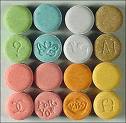
Effects
Ecstasy often contains drugs other than MDMA, which may or may not be similar in effect to MDMA. Some of the other drugs include caffeine, ephedrine, amphetamine, dextromethorphan, ketamine, or LSD. Ecstasy sometimes contains highly toxic drugs, such as PMA (paramethoxyamphetamine), which can be lethal even in low doses.
Ecstasy affects the chemistry of the brain, in particular by releasing a high level of serotonin. Serotonin is a chemical in the brain that plays an important role in the regulation of mood, energy level, and appetite, among other things. Ecstasy increases body temperature, blood pressure, and heart rate, which can lead to kidney or heart failure, strokes, and seizures. Ecstasy may cause jaundice and liver damage.
The use of ecstasy causes an involuntary grinding of the teeth. Over time, users wear down the enamel of their teeth. Ecstasy also causes
Street Names
Adam, Beans, Blue Lips, Blue Kisses, Decadence, Disco Biscuits, Doctor, “E”, Essence, Eve, Kleenex, Hug Drug, Love Drug, Scooby Snacks, Lovers’ Speed, Sweethearts, X, X’ing, XTC, Tulips, Green Nips, White Octagons.
GHB (Gamma-Hydroxybutyric Acid)

Description
GHB was formerly sold by health-food stores and gyms as a sleep aid, fat burner, and enhancer of muscle definition. It has been used in Europe as a general anesthetic, a treatment for insomnia, an aid for childbirth, and for alcohol withdrawal syndrome. In the last few years, it has become popular for being like an alcohol with a hangover-free high.
GHB is turning out to be addictive; it is starting to be used in different nightclubs to have the same effect that Rohypnol has, which has an end result of a sexual assault case. It can easily be mistaken for water, by it is a clear liquid that is usually stored in 30 mL plastic bottles or even Gatorade bottles.
Consumption
It is consumed in a powder form, and you measure it by a dose. It can also come in a liquid form. When in a liquid form, there are many different concentrations, but the user will put a few drops of solution into a glass of water. Since GHB is odourless and tasteless, it can be easily slipped into someone’s drink without detection.

Side Effects
The effects of GHB are dangerous and unpredictable. They are usually felt within 10 to 20 minutes and may last for up to four hours. GHB may make people feel relaxed, euphoric, sedated, and sleepy. It also causes people to lose their inhibitions. Some people feel dizzy for several days after using GHB.
Short-term use of GHB can produce many other effects:
- Dizziness
- Loss of consciousness
- Memory loss
- Loss of coordination (e.g., stumbling, jerky movements)
- Nausea, vomiting, and diarrhea
- Decreased breathing
- Decreased blood pressure and heart rate
- Lowered body temperature
- Increased libido (interest in sex)
It is easy to take too much GHB because the amount that produces the desired or pleasurable effects is close to the amount that can cause an overdose. An overdose can cause slowed breathing, coma, seizures, and may even result in death. If you think that a person has overdosed, contact emergency services immediately.
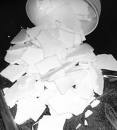
GHB is a potent sedative and can cause users to fall into deep sleep. Users may vomit during sleep and choke.
Taking GHB with other central nervous system depressants, such as alcohol or benzodiazepines, is very dangerous and may result in death. When used together, the depressive effects on the central nervous system are greater than when each drug is used alone. This intense depression of the central nervous system can lead to slowed breathing and ultimately death because the brain stops telling the lungs to breathe.
Street Names
G, Liquid X, Scoop, Georgia Home Boy, Soap, Gook.
Heroin

Description
Most heroin is produced in Asia and Latin America, where opium poppies are grown. Morphine is extracted from the opium gum in laboratories close to the fields, and then converted into heroin in labs within or near the producing country.
In its pure form, heroin is a fine, white, bitter-tasting crystalline powder that dissolves in water. When it is sold on the street, its colour and consistency vary, depending on the manufacturing process and what additives it has been mixed, or “cut,” with. Street heroin may come in the form of a white powder, a brown, sometimes grainy substance, or a dark brown sticky gum. The purity of heroin varies from batch to batch, and can range from two to 98 per cent.
Some additives, such as sugars, starch, or powdered milk, are used to increase the weight for retail sale, or other drugs may be added to increase the effects of the heroin. Quinine may be added to imitate heroin’s bitter taste, making it difficult to determine the purity of the drug.
Consumption
The most common ways of using heroin are:
- injection – either into a vein (“mainlining,” intravenous or I.V. use), into a muscle (intramuscular or I.M. use), or under the skin (“skin-popping” or subcutaneous use)
- snorting – inhaling the powder through the nostril (also called sniffing)
- inhaling or smoking – this method is also referred to as “chasing the dragon,” and involves gently heating the heroin on aluminium foil and inhaling the smoke and vapours through a tube.
Effects
New users often experience nausea and vomiting. Effects include slowed breathing, pinpoint pupils, itchiness, and sweating. Regular use results in constipation, loss of sexual interest and libido, and an irregular or stopped menstrual cycle in women.

Heroin use causes changes in mood and behaviour. People who are dependent on heroin may be docile, and Heroin is dangerous in a number of ways. Overdose is the most immediate danger of heroin use. Heroin depresses the part of the brain that controls breathing. In an overdose, breathing slows down and may stop completely. A person who has overdosed is unconscious and cannot be roused, and has skin that is cold, moist, and blue. Users become compliant after taking heroin, and irritable and/or aggressive during withdrawal.
Street Names
Junk, H, Smack, Horse, Skag, Dope, Mud, Brown Sugar, and Black Tar.
Ketamine

Description
Ketamine, or ketamine hydrochloride, is an injectable anaesthetic. It can be used on both animals and humans, but it is primarily used for veterinary surgery. It is stolen from veterinary clinics and sold on the street, in bars, and at rave parties. Ketamine comes either as a white powder or liquid.
Consumption
Ketamine is generally snorted or smoked. It is commonly combined with ecstasy or marihuana. It is occasionally injected.
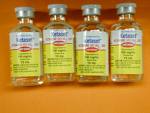
Effects
The effects of ketamine are usually felt between one and ten minutes after taking the drug. Users report a drunken and dizzy feeling and a quick numbness in the body. The range of visual experiences reported includes blurred vision, seeing “trails,” “astral travel,” and intense and terrifying hallucinations. Some report feelings of weightlessness, and “out-of-body” or “near-death” experiences.
When ketamine is taken in lower doses, users may feel sleepy, distracted, and withdrawn. They may find it more difficult to think clearly, feel confused, and have a distorted perception of time and body. At higher doses, they may babble, not remember who or where they are, stumble if they try to walk, feel their hearts race, and find it difficult to breathe. Too high a dose of ketamine causes loss of consciousness.
Ketamine prevents the user from feeling pain. This means that if an injury occurs, the user may not know it. Depending on the amount of drug taken, those under its effects may have difficulty standing up or speaking, resulting in an increased risk of injury. It may also cause vomiting. Eating or drinking before taking the drug increases the risk of choking on vomit.
When taken in higher doses, ketamine may depress the central nervous system. This can reduce the level of oxygen that gets to the brain, heart, and other muscles, and may even cause death. Ketamine sold at clubs may be mixed with other drugs, which, in combination, could make it even more dangerous. Combining ketamine with alcohol or other sedatives can be fatal.

Street Names
Special K, K, Ket, Vitamin K, Cat Tranquilizers, Black Hole, Kit Kat, Cat Valium, Super C, Horse Tranquilizers.
Magic Mushrooms

Description
There are about 12 different types of magic mushrooms that grow wild throughout the UK in the autumn, which have an extreme hallucinogenic effect. The main type of mushroom that is consumed is Liberty Cap Psilocybe.
The magic mushrooms are small and have a tan colour. When they are touched, they bruise a blue colour. Mushrooms are often confused with other poisonous, sometimes deadly fungi. If the user is feeling some kind of illness, you should seek medical assistance. The users of mushrooms do not feel addicted to them, and there are no withdrawal symptoms.

Consumption
The mushrooms can be eaten raw or they can be cooked, stewed in tea and drank, or dried out and stored. When consuming mushrooms, people generally take between 1 to 5 grams per time.

Side Effects
The magic mushrooms will send you on a trip. The trip can be either good or bad. Either a good trip or a bad trip can be very random and sometimes have very frightening effects. The trips all depend on the mood you’re in. Two people can take the same mushrooms, but one person can be on a happy trip for 6 hours while the other person can be lost in paranoia for 6 hours.
Mushrooms can do many different things; they can distort colour, sounds, and objects. Speed up and slow down time and movement. Make you feel very emotionally sensitive. Also, the mushrooms can make you feel sick, tired, and disoriented.
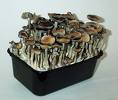
Negative effects Include:
Physical: Chills
Sensory: Auditory effects
Emotional: Panic states
Intellectual: Confused thinking
Street Names
Shrooms, Liberties, Magics, Mushies, Fly Agaric.
Marihuana

Description
Marihuana comes from cannabis sativa, otherwise known as the hemp plant. It is a green plant-like material with small oval seeds, long, thin leaves, and flowers varying in colour from light green to brownish green. Other forms of marihuana are hashish and hash oil..
Active Ingredient
Delta 9 Tetrahydrocannabinol (THC), resin from the plant % of THC in marihuana has jumped from an average of 3 – 7 % in the 1980s to 10 – 20 % today. It is found in all parts of the plant, but is most concentrated in the buds and flowering parts.
Consumption
Smoking (cigarette, pipe), oral ingestion, 1 to 4 hours.
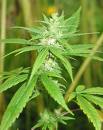
Effects
In a low dose inducement, marihuana creates a sense of well-being, a dreamy state of relaxation, vivid sense of smell, sight, taste & hearing, alterations in thought formation and expression. This causes an intoxication of the brain and impaired coordination. Pupils can become dilated, and eyes can become red (not bloodshot).
High-dose reactions are intensified. Reactions include: experience of shifting sensory imagery, rapidly functioning emotions, fragmented thoughts with disturbed associations, impaired memory, dulling of attention, loss of personal identity, fantasies, and hallucinations.
Street Names
Mary Jane, Weed, Grass.
| Immediate Effects | Long-Term Effects |
|---|---|
| Euphoria Increased pulse rate Impairment of short-term memory Impaired coordination Impaired driving ability Restlessness Anxiety Increased appetite Confusion Impaired motor ability | Hallucinations (strong doses) Toxic effect on brain nerve cells Increased risk of lung cancer Risk of chronic bronchitis Energy loss Respiratory diseases/cancer Slow, confused thinking Memory impairment Apathy |
Meth (Methamphetamine)

Description
Methamphetamine belongs to a family of drugs called amphetamines– powerful stimulants that speed up the central nervous system. The drug is man-made (synthetic), manufactured using ephedrine or pseudo-ephedrine, the active ingredient in cold medicines. Other chemicals that are used include: acetone, drain cleaner, lithium, iodine, paint thinner, kerosene, and red phosphorus. The drug often has a strong ammonia smell due to the incomplete clearing of solvents.
Consumption
Smoking or injecting crystal meth
Snorting or oral ingestion

Effects
Methamphetamine causes increased heart rate and blood pressure, which can lead to strokes and death. High dose use can result in violent behaviour, anxiety, confusion, weight loss, and insomnia. Other effects include risk of convulsions, respiratory problems, irregular heartbeat, and extreme anorexia.
With long-term use, psychosis can develop, including paranoia, mood disturbances, delusions, and hallucinations. For example, people may feel the sensation of insects creeping on the skin, and as a result, scratch and pick at their skin until there are open sores, which can become infected.
Another problem found among crystal meth users is “meth mouth.” Many users often have rotting teeth, and it’s not known exactly why, although it may be because of a reduced blood flow to the teeth and gums, and dry mouth from less saliva.
Street Names
Bathtub Crank, Crank, Crystal, Chicken Feed, Meth, Pink, Redneck Cocaine, Tick Tick, Wash.
Pain Killers

Description
Pain killers are prescription drugs that are used to treat patients with severe pain and/or to help manage their pain after surgery. It also helps patients who have chronic pain.
When abusing this substance, it is 50 to 100 times more potent than morphine. Pain killers are not addictive, you continue to take the substances due to your body becomes dependent on the substance, and you have to take them to feel normal.
Consumption
When prescribed by a doctor, pain killers are often consumed by injection, transdermal patch, or in lozenge form. Generally, when pain killers are prescribed by a doctor, you would take them with meals or have something to eat before taking them.

Effects
For non-medical uses, your body becomes very dependent. Side effects include amplifying their potency, euphoria, drowsiness, depression, nausea, confusion, constipation, sedation, unconsciousness, and coma.
Street Names
China Girl, Jackpot, Murder, Oxy, Oxy 80’s, Perks, Hillbilly Heroin.
Rohypnol

Description
Rohypnol is a powerful tranquilizer that produces strong sedative effects. This drug is in the same recreational drug family as GHB and Ketamine. It is not legal in Canada but is used in European countries as a pre-surgery anesthetic, and also to treat short-term sleeping problems.
Rohypnol has been linked to many sexual assault cases, due to it is a fast-acting sleeping pill, and will erase the victim’s memory for the night. Due to all the sexual assaults involving Rohypnol, the manufacturer has changed the appearance of the drug. When slipped into a drink, it is known to have blue particles floating in the drink. Rohypnol is sold in the form of a small white tablet or a powder. It is very soluble in water, also is tasteless and odourless.
Consumption
Generally, Rohypnol is taken orally as a pill. Occasionally, the pill is ground up and sniffed. One side of the pill is dashed like Tylenol, and on the other side is the name ROCHE. Most commonly mixed with alcohol. In European countries, there was an alcohol solution of Rohypnol that was injected into your system.
Effects
Rohypnol is a very powerful drug. Even just consuming a small dose can have an effect on the user for 8 to 12 hours. Rohypnol can be very dangerous. After taking the drug, the consumer will have little to no memory of the night the drug was taken.
The most common side effects are vomiting, diarrhea, and headaches. It can also cause very rapid mood swings (extreme rage, depression, and vulnerability).
Combining Rohypnol with alcohol increases the side effects. When mixed with alcohol, it will slow down your heart rate and breathing. If taking higher doses with alcohol, the body will shut down, and breathing stops.
Street Names
Roofies, Date Rape Drug, Rophies, Babtists, Circles, Forget-me-pill.
Parent Support Groups
The Chatham-Kent Police Service is pleased to partner with two local parent support groups:


